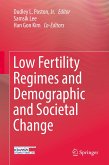This volume examines ten economically advanced countries in Europe and Asia that have experienced different levels of fertility decline. It offers readers a cross-country perspective on the causes and consequences of low birth rates and the different policy responses to this worrying trend.
The countries examined are not only diverse geographically, historically, and culturally, but also have different policies and institutions in place. They include six very-low-fertility countries (Austria, Czech Republic, Hungary, Italy, Spain, and Taiwan) and four that have close to replacement-level fertility (United Kingdom, Norway, Canada, and France).
Although fertility has gone down in all these countries over the past 50 years, the chapters examine the institutional, policy, and cultural factors that have led some countries to have much lower fertility rates than others. In addition, the final chapter provides a cross-country comparison of individual perceptions aboutobs
tacles to fertility, based on survey data, and government support for families. This broad overview, along with a general introduction, helps put the specific country papers in context.
As birth rates continue to decline, there is increasing concern about the fate of social welfare systems, including healthcare and programs for the elderly. This book will help readers to better understand the root causes of such problems with its insightful discussion on how a country's institutions, policies, and culture shape fertility trends and levels.
The countries examined are not only diverse geographically, historically, and culturally, but also have different policies and institutions in place. They include six very-low-fertility countries (Austria, Czech Republic, Hungary, Italy, Spain, and Taiwan) and four that have close to replacement-level fertility (United Kingdom, Norway, Canada, and France).
Although fertility has gone down in all these countries over the past 50 years, the chapters examine the institutional, policy, and cultural factors that have led some countries to have much lower fertility rates than others. In addition, the final chapter provides a cross-country comparison of individual perceptions aboutobs
tacles to fertility, based on survey data, and government support for families. This broad overview, along with a general introduction, helps put the specific country papers in context.
As birth rates continue to decline, there is increasing concern about the fate of social welfare systems, including healthcare and programs for the elderly. This book will help readers to better understand the root causes of such problems with its insightful discussion on how a country's institutions, policies, and culture shape fertility trends and levels.
"Each chapter is written by a country expert who presents recent fertility trends and discusses the social, economic, institutional, historical, and cultural factors affecting fertility as well as policies. ... an invaluable resource for students, researchers, and policymakers, providing comprehensive and highly informative expositions of the causes of low fertility in high income countries." (Population and Development Review, Vol. 43 (1), March, 2017)








